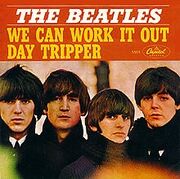
We Can Work It Out Single

The Beatles - We Can Work it Out
We Can Work It Out is a song written by John Lennon and Paul McCartney and released by The Beatles as a "double A-sided" single with "Day Tripper", the first time both sides of a single were so designated in an initial release.
Composition[]
McCartney wrote the words and music to the verses and the chorus, with lyrics that "might have been personal", probably a reference to his relationship with Jane Asher.[1] McCartney then took the song to Lennon:
- "I took it to John to finish it off, and we wrote the middle together. Which is nice: 'Life is very short. There's no time for fussing and fighting, my friend.' Then it was George Harrison's idea to put the middle into waltz time, like a German waltz. That came on the session, it was one of the cases of the arrangement being done on the session."[1]
With its intimations of mortality, Lennon's contribution to the twelve-bar bridge contrasts typically with what Lennon saw as McCartney's cajoling optimism,[2] a contrast also seen in other collaborations by the pair, such as "Getting Better" and "I've Got a Feeling". As Lennon told Playboy in 1980:
- "In We Can Work It Out, Paul did the first half, I did the middle eight. But you've got Paul writing, 'We can work it out / We can work it out' — real optimistic, y'know, and me, impatient: 'Life is very short, and there's no time / For fussing and fighting, my friend.'"[3]
Based on those comments, some critics overemphasised McCartney's optimism, neglecting the toughness in passages written by McCartney,[2] such as "Do I have to keep on talking until I can't go on?". Lennon's middle shifts focus from McCartney's concrete reality to a philosophical perspective in B minor, illustrating this with the waltz-time section suggested by George Harrison that leads back to the verse,[1] possibly meant to suggest tiresome struggle.[2]
Music critic Ian MacDonald said:
- "[Lennon's] passages are so suited to his Salvation Army harmonium that it's hard to imagine them not being composed on it. The swell-pedal crescendos he adds to the verses are, on the other hand, textural washes added in the studio, the first of their kind on a Beatles record and signposts to the enriched sound-palette of Revolver."[2]
Recording and release[]
The Beatles recorded "We Can Work It Out" on October 20, 1965, four days after its accompanying single track, with an overdub session on 29 October. They spent nearly 11 hours on the song, by far the longest expenditure of studio time up to that point.
Released on December 3, 1965 in Britain, the single entered the charts at #1 on December 8, 1965. In the United States, it was released on December 6, 1965; it entered the Billboard Hot 100 at #36 on December 18, and reached #1 on January 8, 1966. The flip side, "Day Tripper" entered the Billboard Hot 100 at #56 and reached #5.
Credits[]
- Paul McCartney - lead vocals, bass (1963 Hofner 500/1)
- John Lennon - acoustic guitar (Gibson J-160E), backing vocals, harmonium
- George Harrison - acoustic guitar (1964 Gibson J-160E)
- Ringo Starr - drums, tambourine
References[]
- ↑ 1.0 1.1 1.2 Miles, Barry (1997). Paul McCartney: Many Years From Now. New York: Henry Holt and Company. ISBN 0-8050-5249-6; page 210
- ↑ 2.0 2.1 2.2 2.3 MacDonald, Ian (2005). Revolution in the Head: The Beatles' Records and the Sixties (Second Revised ed.). London: Pimlico (Rand). ISBN 1-84413-828-3; pages 171–172
- ↑ Sheff, David (2000). All We Are Saying: The Last Major Interview with John Lennon and Yoko Ono. New York: St. Martin's Press. ISBN 0-312-25464-4; pages 177–178.
